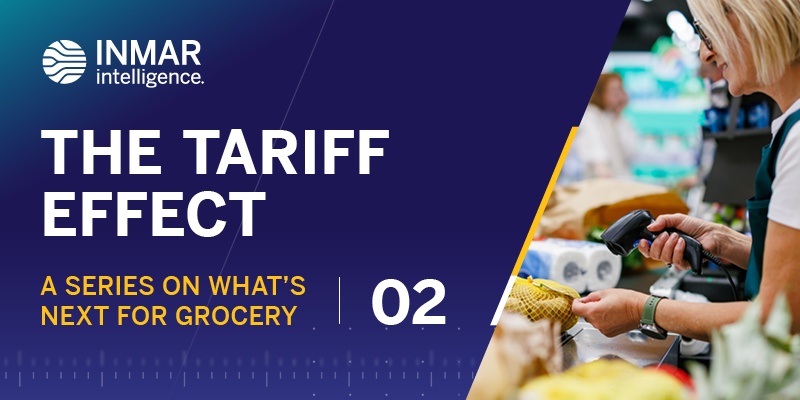
This blog is part of our ongoing series exploring how tariffs, inflation, and shifting economic forces are reshaping shopper behavior and business strategy in the grocery industry. If you missed the first post, “Navigating Tariffs, Inflation, and Uncertainty for CPGs and Retailers,” you can catch up here.
Even weeks after the latest round of U.S. tariff announcements, much remains unclear. For retailers and CPG brands, the ripple effects are still taking shape, particularly as concerns grow around grocery pricing, sourcing, and long-term consumer confidence.
Even though most of our food imports come from Canada and Mexico, which are exempt from tariffs per the U.S.-Mexico-Canada Agreement (USMCA), many agricultural inputs and food products still face increased costs due to broader supply chain impacts. As a result, shoppers will continue to feel the squeeze at the checkout line.
According to the University of Michigan’s Consumer Sentiment Index, consumer sentiment continues to decrease, marking the second-lowest reading in the survey’s history going back to 1952, and the lowest since June 2022 when inflation hit 9.1%. Shoppers are preparing for higher prices, whether it’s from inflation, tariffs, or the combination of the two. In fact, 57% of consumers say that the impact tariffs will have on food availability, price, and/or safety is their top concern for 2025, according to The Food Industry Association (FMI)
All Product Categories — Imported & Local — Face Pressure
Whether your product, your ingredients or your manufacturing are US based, international or some combination of the two–all brands are poised to be impacted by the current climate
How? Tariffs on packaging materials like aluminum cans, plastic containers, and glass bottles are increasing production costs across a wide range of categories. Even brands that source their ingredients domestically are seeing higher expenses due to these rising material costs.
Add in ongoing supply chain disruptions, including transportation delays, ingredient shortages, and climate-related challenges affecting agriculture, and the result is clear: Even locally-produced grocery items are becoming more expensive to manufacture and distribute.
For consumers, that likely means not only higher prices at the shelf but also limited availability, a smaller assortment of brands, particularly in categories that rely heavily on imported inputs, packaging materials, or complex logistics.
Turning Tariff Trouble into Opportunity
Across the board, consumers are more selective now. They’re more likely to reevaluate the brands they buy based on both dollar value and the brand’s values.
To succeed in this environment:
Target intentionally.
Use first-party shopper data to identify under-reached or at-risk audiences. Retailers can surface value-focused customers through loyalty programs and app behavior. Brands can partner Inmar to activate data-driven retail media strategies that leverage our partners’ first-party data and target newer, price-conscious segments, like younger shoppers entering the category.
Incentivize and do so strategically.
In 2024, rising prices drove 53% of shoppers to start looking for coupons for the first time as shared in the 2024 Inmar Shopper Insights Survey. Economic pressure doesn’t just increase coupon use; it expands it to a broader audience, creating a key opportunity for CPGs and retailers.
Offers like digital coupons, rebates, and loyalty rewards can encourage trial and build long-term value without relying on blanket discounts. Multi-item promotions or limited-time digital offers can boost both trial and basket size.
Lead with value across media.
Promotions don’t work if no one sees them. Consider multichannel media and contextual placements that match shopper intent, like mobile offers pre-trip, signage with a QR code to coupons while in-store, and loyalty rewards post-trip.
Lean into your story.
Highlight what sets you apart from competitors, whether it’s local sourcing, sustainability, quality, your mission, etc. In a high-cost environment, shoppers are more likely to stay loyal when they feel a brand or retailer aligns with their values.
Show up at the right moments.
Focus on high-impact consumption occasions, from weeknight meals to special gatherings, where relevance could outweigh price sensitivity. Think about promotions tied to sporting events, holidays, or seasonal rituals where your product naturally fits.
Final Takeaway
Tariffs and inflation are reshaping how shoppers think, spend, and stay loyal. Whether you’re selling groceries or gin, the brands that win in 2025 will be the ones that make shoppers feel seen, in control of their spending, and show up in the moments that matter most.
Stay tuned as we continue to track tariff developments and shopper sentiment and behavior shifts as a result, and, in the meantime, you can see how Jägermeister saw success aligning their media and incentives strategies here.
